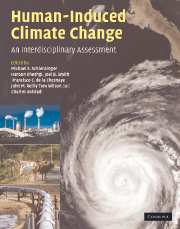Book contents
- Frontmatter
- Contents
- List of contributors
- Preface
- Part I Climate system science
- 1 The concept of climate sensitivity: history and development
- 2 Effect of black carbon on mid-troposphere and surface temperature trends
- 3 Evaluating the impacts of carbonaceous aerosols on clouds and climate
- 4 Probabilistic estimates of climate change: methods, assumptions and examples
- 5 The potential response of historical terrestrial carbon storage to changes in land use, atmospheric CO2, and climate
- 6 The albedo climate impacts of biomass and carbon plantations compared with the CO2 impact
- 7 Overshoot pathways to CO2 stabilization in a multi-gas context
- 8 Effects of air pollution control on climate: results from an integrated global system model
- Part II Impacts and adaptation
- Part III Mitigation of greenhouse gases
- Part IV Policy design and decisionmaking under uncertainty
- Index
- Plate section
- References
6 - The albedo climate impacts of biomass and carbon plantations compared with the CO2 impact
from Part I - Climate system science
Published online by Cambridge University Press: 06 December 2010
- Frontmatter
- Contents
- List of contributors
- Preface
- Part I Climate system science
- 1 The concept of climate sensitivity: history and development
- 2 Effect of black carbon on mid-troposphere and surface temperature trends
- 3 Evaluating the impacts of carbonaceous aerosols on clouds and climate
- 4 Probabilistic estimates of climate change: methods, assumptions and examples
- 5 The potential response of historical terrestrial carbon storage to changes in land use, atmospheric CO2, and climate
- 6 The albedo climate impacts of biomass and carbon plantations compared with the CO2 impact
- 7 Overshoot pathways to CO2 stabilization in a multi-gas context
- 8 Effects of air pollution control on climate: results from an integrated global system model
- Part II Impacts and adaptation
- Part III Mitigation of greenhouse gases
- Part IV Policy design and decisionmaking under uncertainty
- Index
- Plate section
- References
Summary
Introduction
Changes in land use and the consequent changes in land-cover properties modify the interactions between the land surface and the atmosphere locally and regionally (Kabat et al., 2004). Important factors in these interactions are the biochemical fluxes of CO2 and other trace gases, and the biophysical fluxes of energy and water vapor. Modeling studies, well validated with detailed observations, show that changing land-use in the past centuries influenced local, regional, and probably also global climate patterns (e.g. IPCC, 2001). Historically, land-use mediated climate change appears to be an important factor (Brovkin et al., 1999). In mid to high latitudes, for example, land-use changes influence surface-air temperature because of the large difference in surface albedo between different land covers, such as cropland and forest in snow-covered conditions (Robinson and Kukla, 1985; Bonan et al., 1995; Harding and Pomeroy, 1996; Sharrat, 1998). Emission scenarios, required to estimate future climate change, nowadays often include detailed changes in land-use patterns and the consequent changes in sources and sinks of trace gases (e.g. Strengers et al., 2004). The biophysical consequences on the climate systems are, however, often neglected. It is therefore important to examine the role of land-use changes in determining future climates (Pielke Sr et al., 2002).
Future land-use change does not only include deforestation and afforestation as a consequence of expanding or contracting agriculture. Other land uses, such as plantations for carbon sequestration or energy production (to substitute fossil fuels), are likely to become more important.
- Type
- Chapter
- Information
- Human-Induced Climate ChangeAn Interdisciplinary Assessment, pp. 72 - 83Publisher: Cambridge University PressPrint publication year: 2007



